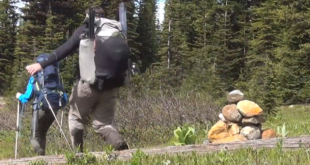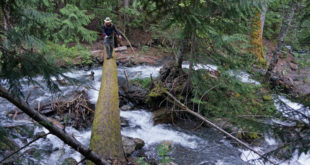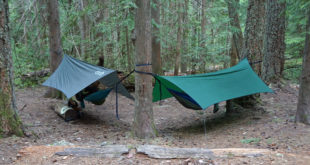Well it finally happened. After training and hiking I managed to get things organized for a 2 day summit attempt of Huayna Potosí.
There’s a bit of debate as to how tall it is, with the official height being around 6088 meters or just shy of 20000 feet. This is in a country where official altitudes can be off as much as 500 meters. Most people at the summit (including one that I summited with) find that their GPS reads about 6100+ meters, or safely above the magic 20000 feet mark.
Usually tourists tackle the mountain in 3 days to allow a bit more acclimatisation time at the high camp of 5180 meters (17 000 feet) before attempting the summit. We did it in 2 as I have been in La Paz for a while and time was a constraint.
Leaving La Paz, we drove up towards Paso Zongo, where on both sides there are mountains over 5000 meters and a glacial blue lake sits just below you. An incredible start to a trip.
Disembarking at the Refugio or base camp (4700 m or 15 400 feet) we stopped for lunch and some coca tea (it helps with the altitude) and discussed plans for the day. A couple hours to the high camp involving regular hiking and a bit of scrambling then it was R&R before the summit attempt the next morning.
We had 2 porteadores (porters) that helped with our stuff. We could have done it without, but it helps support the local economy and makes it more of a relaxing trip.
Huayna is very popular so it has a nicely worn trail, which we followed past a glacier, across a stream and then along a ridge before we scrambled up a rocky trail littered with leftover ice. Apart from a small section of ice steps, the going was non technical and my trekking poles did the trick. Within 2 hours we were at the high camp “Campo Rocas Alto” of 5180 feet where another stone “refugio” sits on the edge of the snow line.
After taking a whole bunch of photos and talking about the route, we relaxed inside with some more food and drink. After chatting with the others that were attempting the summit the next morning we decided to head to bed.
Unfortunately, as is often the case with mountains, the night brings strong wind bellowing up the mountain. I found it hard to sleep as the sounds made me feel that at any moment the roof would be torn off this tiny shelter and leave us exposed to the cold.
This fear was somewhat confirmed at 2 am when I went out to use the facilities and after sitting down on the frozen seat the outhouse door blew open and off its hinges.
We had decided to start an hour later than the others to give us a bit of calm and because my guide Gonzalo felt my pace was quicker than the rest. After getting a few hours of shut-eye and a couple more hours of lying in bed and listening to the rattle of the roof joists we decided to eat a light breakfast and gear up.
We wouldn’t need the ice axe for the first section so we stowed them quick to hand and took out the trekking poles instead. The first hour is straight forward as you cut up to the left and then back to the right. Pretty much every time you start to get tired it levels out a bit to give you a breather, before sending you up another steep section.
My Hydration hose froze solid despite blowing into it to get rid of water in it and I had to store the hose behind me back to thaw it out. The water was essential for the altitude, I’m glad I brought 3 liters, despite the weight.
When I rested, it was not so much to give my legs a break, but more to give my lungs a chance to catch up from the lack of air. Doing the Choro trail a few weeks before had been a good idea.
We followed the trail and marked the red flags that indicated crevasses and ascended till we came to a wall. There was one slightly technical section filled with crevasses where we needed to pull out the ice axe and dig in with the crampons to get up, but after that it was smooth sailing to the final ascent. We stopped for photos and a snack when the sun started to crest and the moon was outlined, but then pushed on.
When we got to the final crest, we had caught up with the other teams. We dumped the trekking poles and switched back to the ice tool and climbed up the ridge that snaked its way to the summit. The wind was blowing up one of the faces so we tried to keep low until we got to the top.
At 7:20 AM we reached the summit and the sun had come up not long before. After taking a break, drinking a nice cup of hot chocolate and coffee mixed we congratulated each other, thanked our guides and finished the adage: What goes up, must come down.
Although it took us a bit over 4 hours to get to the top, we only needed an hour and a bit to make it back to the high camp. That included the sight seeing and photo taking of the amazing sights that we couldn’t see on the way up in the dark.
At the high camp again, we took only as much time as we needed to pack up our stuff and have another drink before we hopped back down the trail to the car. Once there we recounted our exploits, settled our debts and got in the car and headed home.
It was then that I realized what we had just finished doing. in just over 24 hours I had zipped up to around 20000 feet (not even possible back in Canada), for the first time in my life had summitted a significant peak and left that all behind. Needless to say, I’m already planning my next peak.
 The Outdoor Adventure Giving you tips, tricks & recommendations to help make adventuring in the Outdoors fun, safe & exciting for you and your kids.
The Outdoor Adventure Giving you tips, tricks & recommendations to help make adventuring in the Outdoors fun, safe & exciting for you and your kids.




